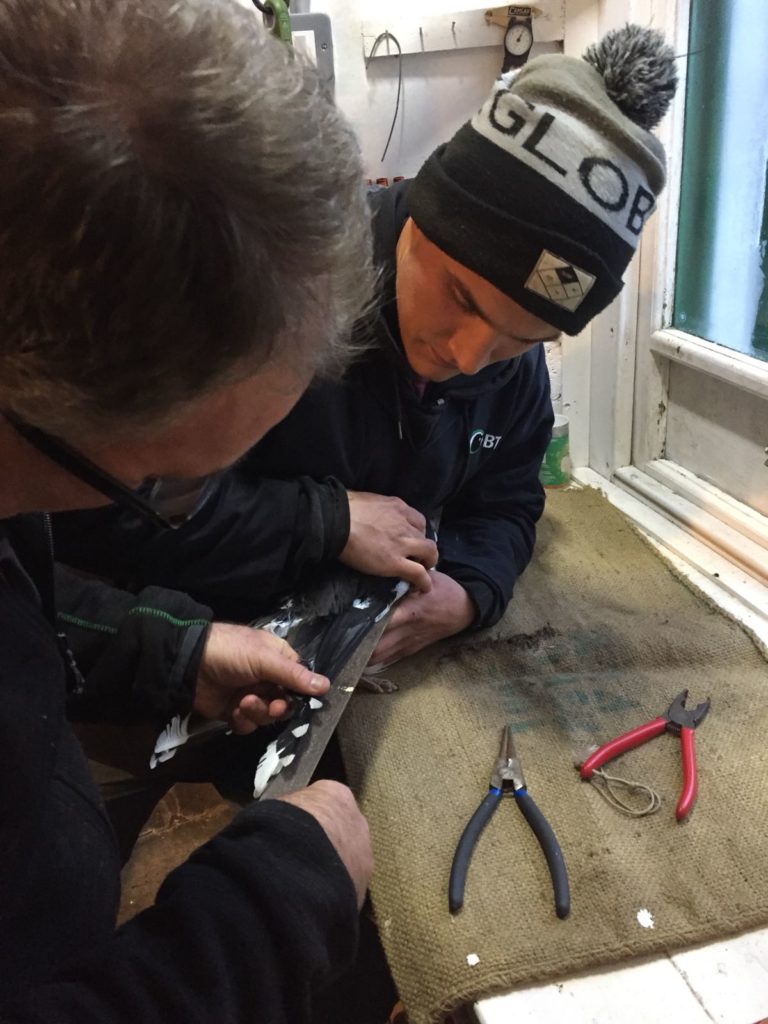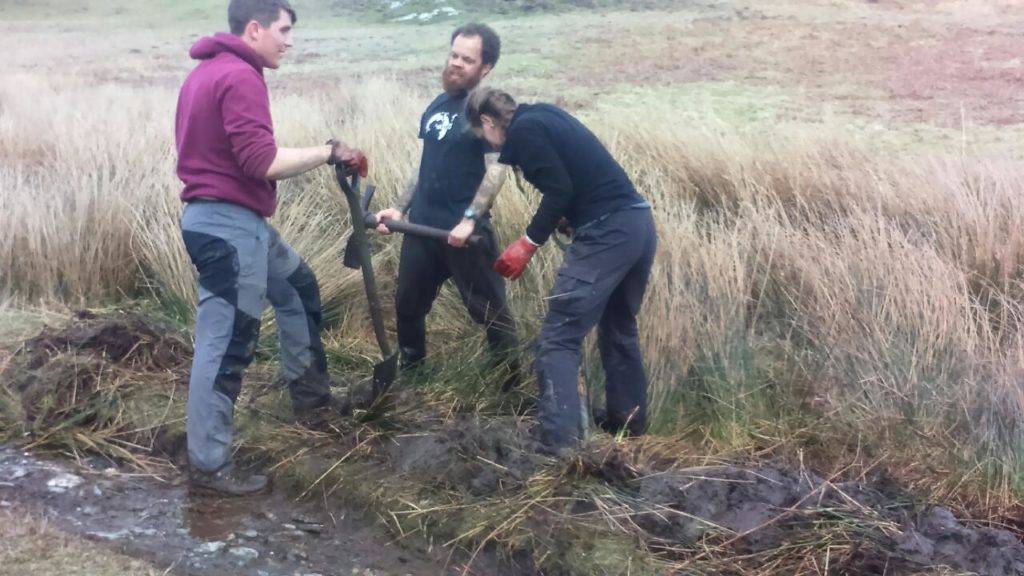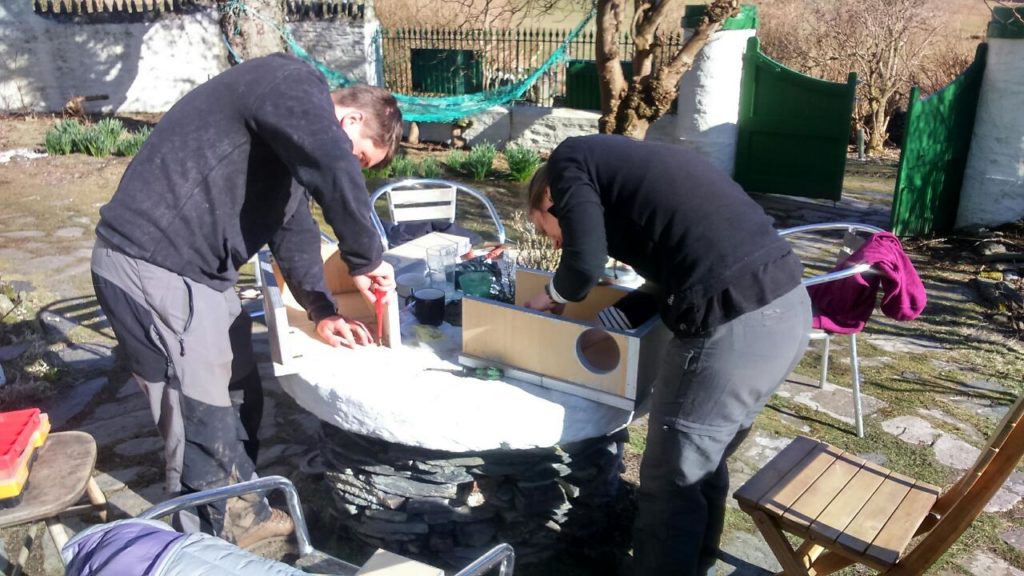In order to gain the experience necessary to secure a ringing permit, it is often advantageous for ringing trainees to seek opportunities to go out with other groups. This article has been prepared by Stephen Vickers and Kirsty Franklin summarising two weeks of volunteering on the Calf of Man.
We arrived on the Isle of Man by plane in the early hours of
March 26 and headed straight to the Calf of Man by boat. The
entire journey was very easy; with shopping ordered in advance and
delivered to the island on a weekly basis, we had no worries about bringing
food. We left on April 9 after 14 days on the island, which was as
much time as we could squeeze around work.
March 26 and headed straight to the Calf of Man by boat. The
entire journey was very easy; with shopping ordered in advance and
delivered to the island on a weekly basis, we had no worries about bringing
food. We left on April 9 after 14 days on the island, which was as
much time as we could squeeze around work.
Ringing takes place on a daily basis on the Calf when
weather permits. In fact, we both had a bird in our hands less than 10 minutes
after stepping off the boat, so not a bad welcome! The ringing mostly consisted
of mist netting and the use of two Heligoland traps, where we were treated to good
numbers of goldcrests, goldfinches, robins, and more. This provided us with plenty
of ringing and extraction experience, a great help on our way to our ‘C’
permits. The weather wasn’t always on our side, but we were still lucky enough
to process 435 and extract 621 birds between
us in that time.
weather permits. In fact, we both had a bird in our hands less than 10 minutes
after stepping off the boat, so not a bad welcome! The ringing mostly consisted
of mist netting and the use of two Heligoland traps, where we were treated to good
numbers of goldcrests, goldfinches, robins, and more. This provided us with plenty
of ringing and extraction experience, a great help on our way to our ‘C’
permits. The weather wasn’t always on our side, but we were still lucky enough
to process 435 and extract 621 birds between
us in that time.
Below is a summary of numbers processed by the pair of us,
and does not include birds processed by others at the obs while we were there:
and does not include birds processed by others at the obs while we were there:
|
Species
|
Kirsty
|
Stephen
|
|
Blackbird
|
3
|
7
|
|
Blackcap
|
4
|
6
|
|
Black redstart
|
1
|
0
|
|
Chaffinch
|
9
|
14
|
|
Chiffchaff
|
17
|
23
|
|
Dunnock
|
1
|
1
|
|
Great black-backed gull
|
0
|
1
|
|
Goldcrest
|
87
|
84
|
|
Goldfinch
|
38
|
37
|
|
Greenfinch
|
0
|
1
|
|
Manx shearwater
|
7
|
7
|
|
Meadow pipit
|
3
|
2
|
|
Redwing
|
0
|
2
|
|
Reed bunting
|
2
|
2
|
|
Ring ouzel
|
1
|
0
|
|
Robin
|
13
|
15
|
|
Shag
|
2
|
2
|
|
Siskin
|
3
|
6
|
|
Starling
|
1
|
1
|
|
Wheatear
|
2
|
2
|
|
Willow warbler
|
16
|
9
|
|
Wren
|
1
|
2
|
|
Total
|
211
|
224
|
Unsurprisingly at a bird observatory, we were treated to some
nice (uncommon) birds. Kirsty was lucky enough to ring both a female ring ouzel,
and a male black redstart. Whilst Stephen lost the coin toss on both uncommon birds, he
got a chance to ring in his words “the best seabird in the world”.
nice (uncommon) birds. Kirsty was lucky enough to ring both a female ring ouzel,
and a male black redstart. Whilst Stephen lost the coin toss on both uncommon birds, he
got a chance to ring in his words “the best seabird in the world”.
After
finding a recently deceased rabbit, Stephen convinced the warden to let him use
the large 1m2 spring trap with the rabbit as bait. Two days
later, success struck in the shape of an adult great black-backed gull. As
reward for the work he put towards catching it, Stephen was the lucky person to
ring the bird. He hasn’t stopped speaking about it since!
finding a recently deceased rabbit, Stephen convinced the warden to let him use
the large 1m2 spring trap with the rabbit as bait. Two days
later, success struck in the shape of an adult great black-backed gull. As
reward for the work he put towards catching it, Stephen was the lucky person to
ring the bird. He hasn’t stopped speaking about it since!
We also had a huge amount of fun visiting several breeding
shag colonies, to make assessments towards measuring breeding productivity and
attempt to catch some adults on the nest. With 27 nests found, some already at
hatchling stage, it proved a big success. To top it off, we both got to ring
two adult shags each. A great species to ring, that we wouldn’t get to do with
Gower RG, and which also gave experience with a larger ring size (K ring).
shag colonies, to make assessments towards measuring breeding productivity and
attempt to catch some adults on the nest. With 27 nests found, some already at
hatchling stage, it proved a big success. To top it off, we both got to ring
two adult shags each. A great species to ring, that we wouldn’t get to do with
Gower RG, and which also gave experience with a larger ring size (K ring).
A couple of evenings were spent dazzling Manx shearwaters.
Brown rats decimated Manxie population numbers on the island, and even now
after many years of rat eradication and conservation efforts the population
only stands at approximately 400 pairs. Whilst these numbers don’t quite match
the populations on the Welsh Islands (360,000+ pairs), we had a very successful
time processing 14 individuals between us and were able to get more practice of
dazzling. It was also nice to ring a Manxie on the island where it got its
name!
Brown rats decimated Manxie population numbers on the island, and even now
after many years of rat eradication and conservation efforts the population
only stands at approximately 400 pairs. Whilst these numbers don’t quite match
the populations on the Welsh Islands (360,000+ pairs), we had a very successful
time processing 14 individuals between us and were able to get more practice of
dazzling. It was also nice to ring a Manxie on the island where it got its
name!
Whilst ringing was a big part of why we went to the Calf,
there was also plenty of other work to get stuck into to help with the running
of the observatory. Jobs included drainage ditch digging to create new wetland
scrapes, wildlife walks to contribute to the daily log of species recorded on the
island, scrub clearing, and Manx shearwater nest box building.
there was also plenty of other work to get stuck into to help with the running
of the observatory. Jobs included drainage ditch digging to create new wetland
scrapes, wildlife walks to contribute to the daily log of species recorded on the
island, scrub clearing, and Manx shearwater nest box building.
The Calf of Man was a great place to spend a few weeks
ringing and volunteering, and whilst it was a cold delayed start to spring, we
had great fun and saw some great species.
ringing and volunteering, and whilst it was a cold delayed start to spring, we
had great fun and saw some great species.
Calf of Man Bird Observatory does not currently run a blog,
but frequent updates on their ringing and other observatory activities can be
found via Facebook and Twitter @CalfObs.
but frequent updates on their ringing and other observatory activities can be
found via Facebook and Twitter @CalfObs.
Ornithological warden Aron Sapsford can also be contacted via email.
Photos are below.
Stephen Vickers & Kirsty Franklin
10/04/2018
 |
| Male black redstart |
 |
| Dazzling Manx shearwaters |
 |
| Taking biometric data from the great black back. |
 |
| Female ring ouzel |
 |
| Ringing an adult shag |
 |
||
Male wheatear
|
 |
| Clearing scrub to create net rides |
 |
| Digging drainage ditches |
 |
| Male eider |
